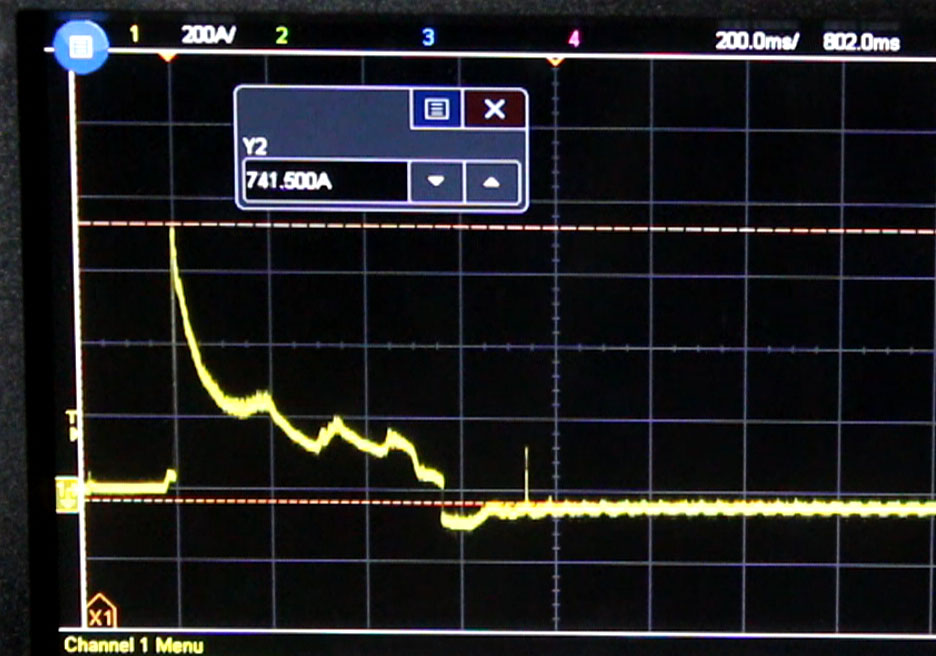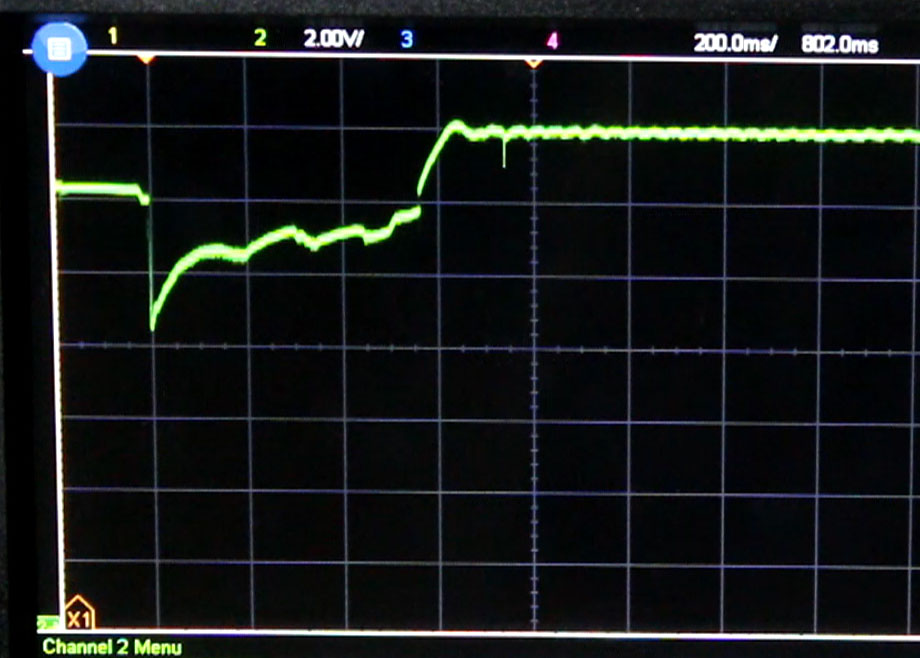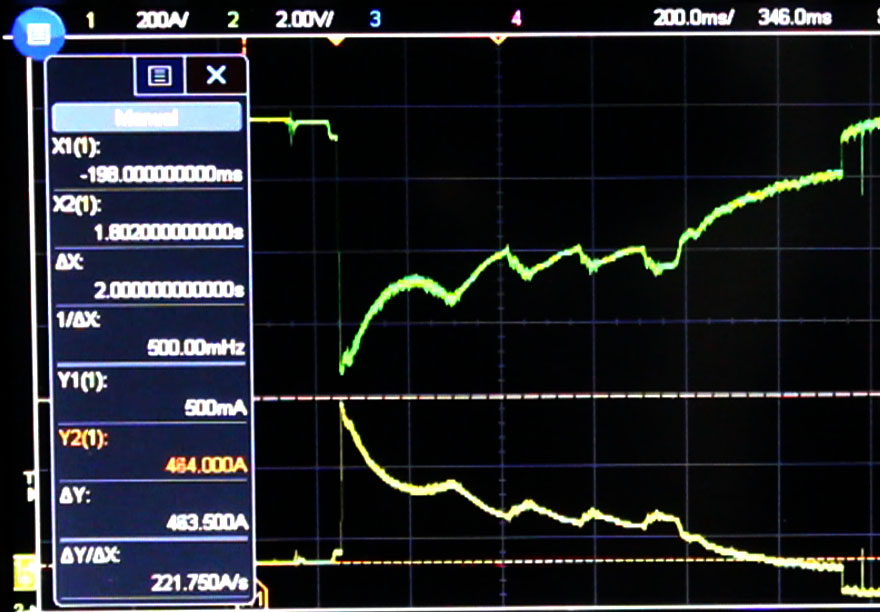Can super capacitors (supercap) alone jump start a car:
But of course they can, if they are rated properly of course. If you want more detail on what supercaps are, you can read this Wiki Page. But in general these especial capacitors have huge amounts of capacity compared to other types of capacitors. They are the bridge between electrolytic capacitors and batteries. At much smaller size, they can store much more electrical charge. The supercaps I used are Eaton XV3560-2R7407-R, which are 400F, 2.7V, 3.2mOhm which can deliver 220A peak at 15 degrees temperature rise. Well I drew more from them and I’m not sorry about it!
Their downside is that majority of them are rated for 2.7V, which is pretty small. One has to put more of them in series in order to get higher voltage rating. But that ends up reducing the total capacitance of the battery. As we know the total capacitance of series capacitors is:

When all capacitors are equal, if we have 6 capacitors for example, the total capacitance would be C/6.
Now to crank a car we need a high voltage capacitor. With 6 supercaps we get a maximum of 16.2V. You may say we could remove one capacitor to get 13.5V total to use in place of a 12V car battery. But as also shown in the video when car is charging the capacitor, the voltage is usually regulated to 14V or sometimes higher. So the more margin the batter.
Now cranking a car takes a lot of current as seen in the plot below. Initially as the crank motor is not running, the only thing holding the motor current back is the motor coil resistance which is generally very small especially for these motors (their inductance is very small). So the current jumps to maximum which in this case is around 740A.

A typical car crank current
As the crank motor starts spinning, the back EMF (voltage generated on the motor coils when turning) picks up and reduces the current into the motor. So the motor current drops to 200A and goes lower. Those ripples in current are due to the change in motor speed as it tries to turn the engine, which is also audible. As soon as the engine turns on, it turns the alternator and charges the battery. This is when the current reverses back into the battery which is around 40A.
The picture below is the voltage of battery when cranking the motor. The battery has some internal resistance which results in voltage drop when current is drown from it. As seen below the voltage almost drops 4V and we know the current was 740A. This means the battery series resistance is around 5.4mOhm. Of course this is a charged battery resistance and will be smaller if the battery is not charged well.

Battery voltage when cranking
Also from the plot above we can calculate the coil resistance of the crank motor, which is around 8.4V on the battery divided by 740A current, or around 11.4mOhm.
Now the supercaps I used have an ESR (Equivalent Series Resistance) of 3.2mOhm each. With 6 of them in series we will have around 6 x 3.2 = 19.2mOhm resistance. This means that when we crank with capacitors, the voltage across the capacitor will drop much more and they provide a smaller in-rush current. This would result in the motor turning slower. This is what we observe in the video as well, and the plot below shows how the crank current is smaller.

Cranking voltage and current with supercaps
The crank current is around 460A and the voltage drops by around 7V from 13.6V. This means the capacitors have 7/460 = 15.2mOhm resistance which is better than expected.
As you see from the plots, while the battery could start the car in less than 600mS, the supercaps started the car in closer to 800mS, which means as expected the crank motor is turning slower. But that is good enough to start the car. Right after the car starts, the capacitors charge and are ready for another crank.
There are two issues with supercaps:
- They have large leakage current, around 1mA for my supercaps, which will drain them fully in about 13 days.
- My supercaps are only good for one crank per charge, meaning if you open the doors and in-cabin lights or other devices turn on, their voltage drops and there won’t be enough juice to crank.
Of course you can get much higher capacity supercaps good for multiple cranking tries before car starts and recharges the capacitors.
Also in many cases when they want to use super capacitors in place of car batteries, they also include a low power battery parallel to the supercaps. The battery can provide the 1mA leakage current for very long period of time. Also if one crank didn’t turn the car on, you can wait for the battery to charge the supercaps for another try.

jump start a car with 9v battres
Interesting to watch! Thanks for sharing this awesome video with us. Please keep sharing!
Hello, I read this article and got some good ideas about the car starting. Really it’s a cool article about starting a car with supercapacitors.
Thanks for sharing
What about on a Harley -Davidson M/C
https://www.youtube.com/watch?v=GPJao1xLe7w
Seriously, you’re my hero of electricity
Wooow
Would you have been able to do the same thing with 6 super capacitor of 100F, 2.7V ?
I really enjoy your videos!
I wish i could see mr. Elertoboom starts a car using a 100 farad 2.7 v i dont know will it work ?
I watched a video about this on youtube years a go by someone else
here is link
https://www.youtube.com/watch?v=z3x_kYq3mHM
700 Farad—my error. Still big
I have assembled a group of 6 7000F (Chinese farads, so who knows) super caps in series. I am looking at the wire connecting the caps and I’m looking at the wire leaving the group of 6 in your demo. It would seem that, if you need heavy cable going to the battery clips, you would need something fairly heavy between the caps, yet the interconnecting conductor doesn’t look to me like it could handle several hundred amps for more than a flash. What am I missing?
Thanks for the video/article. I’d be very interested to see you build another one, incorporating the parallel battery to maintain the supercaps. I wonder how long something like a laptop battery could keep them charged, and what manner of circuit would be required to recharge the “trickle” battery [simple resistors to manage the current passed from the car battery, through the capacitors, and into the small battery?].
I’m still very new to the world of electronics, but I’m doing my best to keep learning every day.
Your videos inspired me to first start googling Ohm’s law and I love double-checking your resistor values, ensuring that my math arrives at the same value as yours, and staring at your circuit diagrams until I understand them [or at least START to understand them].
Thanks for your awesome productions. Keep doing what you do. =)
You can balance these caps very easy. And reduce the leakage current to a degree of uA.
Just research this IC. ALD810026
I would be interesting to see a video about this topic.
Balancing caps ( super-caps )
Thank you
how can we attain 48 volts and 80amp of current
Is it possible to attain 70A from a 60v source while not reducing voltage less than 48v?
Good job. The numbers are exactly what I needed, although the amp value is pretty much different from every car. Mind to tell me your car is, and the fuse used by motor (for cranking) is it using? My car is 1.6T engine with 300A fuse for starter/generator(or alternator?) but i have no equipment to test the amp like you
How did you find the resistance of the capacitors?
It is provided in their datasheet. But you can also measure them. It involves having a series resistor with the cap, send a square wave to it at >10k frequency and look for jump of the voltage when pulse transitions. The jump is due to series ESR of the cap. Having that jump you can calculate the ESR.
Can you let us know whats ur dc power suply and the circuit diagram of the capacitor bank. And also please let us know a way to store 12Kv 60mA from a capacitor bank with the diagram of ur suler capacitor bank. Thanks!
What are the other contacts in the cap for?
Thank you
Mechanical support
Did u use the caps without balancing circuit?
I added 1000 ohm in parallel to each one to balance. Good enough for balancing IMO.
The leakage current its around 3mA in this case?
Hi, I did the same thing. Calculated what resistors I needed and 1k would be good. The thing is they take ages to charge. After having them hooked up to a 12,8V16Ah lifepo4 battery for a full day, the pack still only is at 6,5V, while the battery doesn’t care (only dropped from 13,30V to 13,28V). How can I make them charge faster?
There goes my plan in using the battery/capacitor combo for my car..
I now have 6 of these in series (the Eaton 400F) with each having an 1k resistor to balance. This whole package is put parallel with (battery pack + BMS).
Extra info: The plan was to use the capacitors for starting and the battery for lights/radio/keeping the capacitors full. The caps were added later in parallel as the battery couldn’t provide the starting current peak safely. This whole package should theoretically perform better, last 6x longer and be 6x lighter than a normal lead acid battery at only 3x the price..
Hi! Can you make an article/video about surge protectors? Specifically, I’d like to know if there’s any impact, positive or negative, on other appliances in the same house not plugged into them. Thanks in advance!
Greetings Mehdi,
I’m thinking of buying a current clamp-on meter and I noticed that you’re using Mastech HH2002 multimeter in this video. How’s this multimeter? Would you recommend it?
Thanks
It is a low cost basic multimeter that works. I haven’t checked its accuracy but I’m not expecting high accuracy out of it anyways. Other that that, it works well.
Pingback: Jump Starting a Vehicle with a Bank of Super Capacitors « Adafruit Industries – Makers, hackers, artists, designers and engineers!
I was wondering if I could record parts of your videos in slow motion and post the recordings on my blog at http://dengr557.blogspot.com/ . Will you allow this?
As long as it is parts, and you provide credit, then it is fine.
Thank you!
Ur experiments rock man i have been watching your videos of experimenting since 2015 and i really need an oscilloscope i am a student of hamdard university having Electronics Engineer as a major,i hope u understand
Where did you buy those capacitors?
Digikey
My son is graduating from UVIC as an Electrical Engineer and I want to buy him a present. Where did you buy that sweet Electrical Scope thing ?
Looks like you can get it here https://www.circuitspecialists.com/hantek-200mhz-digital-storage-oscilloscope-dso5202p.html
Awesome video on starter car. I enjoy this video.
Thanks for your good share!
The one I have in this video is like $20k CDN from keysight an ddoes a lot of thing, very high frequency and fancy features. But I also recommend rigol DS1054Z that goes for $500 CDN that is a very good beginner’s scope. The Hantek scope is good too.
Your videos are awesome, keep it up !
In the video you mentioned you were giving away your old scope. My old high school physics professor has an oscilliscope from what feels like the 80s. I fact I noticed when I was using it that it was completely miscalibrated until I adjusted it back to normal.
I was the first to notice that it was giving weird readings and brought it up to him. He blamed it on error on my part, as he believed the oscilliscope which he had bought for the class had to have been perfect. After a long three month argument I finally proved that it was infact miscalibrated and I fixed it. Honestly the whole ordeal kind of severed his relationship with me as a friend. He didn’t like being wrong about something, and as a high school student I probably didn’t handle the situation as appropriately as I could have.
Anyway If you could email me regarding the oscilliscope and maybe potentially sending it to me so that I could give it to him it would be greatly appreciated. He teaches ap physics ap calculus and engineering.
This is especially a difficult year for him because they just changed the physics curriculum and he is struggling with it because he has always been very very successful with the old one.
The tests are on a 1-5 scale with 5 being the best. He was very proud of his test scores in all ap classes being around 4.5 or greater on average, which is ridiculously impressive for a school that makes all ap students required to take the ap test at the end of the year.
I appreciate that you took the time to read this post and I would greatly appreciate if you found the time to reply.
Oh, man! You are great 😀 good job!